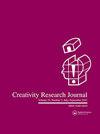美学与艺术心理学的个人视角:生态学上有效的、跨学科的、多样化的方法论
IF 2.5
3区 心理学
Q2 PSYCHOLOGY, EDUCATIONAL
引用次数: 0
摘要
在这篇受邀的论文中,我的目的是通过概述我认为经验主义美学,特别是艺术研究正在或应该走向的方向,向读者介绍我的工作。我将介绍我工作的两个主要焦点:1)在实验室之外和他们的“自然栖息地”研究艺术/美学,即做生态有效的研究(最常见的是在博物馆),以及2)在广义上研究艺术/美学经验的方法论方面:包括理论,测量和分析。作为未来的方向,我看到了向调查潜在结果的转变,以及通过结合跨学科方法和使用更先进的统计建模来确保理论和方法之间更强的联系。我的目的不仅是要展示我过去所做的工作,还要展示我现在所做的工作是如何形成的,以及我认为我的工作发展的方向,以及我认为应该追求的方向,不仅仅是我,还有许多其他人。我选择这种形式是为了能够展示我认为我的工作是如何为这些发展做出贡献的,并且希望在未来也能继续做出贡献。本文章由计算机程序翻译,如有差异,请以英文原文为准。
A Personal Perspective on Psychology of Aesthetics and the Arts: Ecologically Valid, Interdisciplinary, and Diverse Methodologies
In this invited paper, my aim is to introduce the reader to my body of work by outlining where I think empirical aesthetics, and specifically the study of art, is moving or should be moving toward. I will introduce two main foci of my work: 1) studying art/aesthetics outside of the laboratory and in their “natural habitat,” i.e. doing ecologically valid studies (most commonly in the museum), and 2) methodological aspects of studying art/aesthetic experience in a broad sense: including theory, measurement, and analysis. As future directions, I see a shift toward investigating potential outcomes, as well as ensuring a stronger connection between theory and methodology by incorporating interdisciplinary approaches as well as using more advanced statistical modeling. My aim is to show not just what I have done in the past, but also how this shaped the work that I am currently doing as well as the direction that I see my work developing in and that I believe should be pursued, not just by me but by many others. I chose this format in order to be able to show how I think my work contributes to these developments and can, hopefully, also keep contributing in the future.
求助全文
通过发布文献求助,成功后即可免费获取论文全文。
去求助
来源期刊

Creativity Research Journal
Multiple-
CiteScore
5.10
自引率
7.70%
发文量
52
期刊介绍:
Creativity Research Journal publishes high-quality, scholarly research capturing the full range of approaches to the study of creativity--behavioral, clinical, cognitive, crosscultural, developmental, educational, genetic, organizational, psychoanalytic, psychometrics, and social. Interdisciplinary research is also published, as is research within specific domains (e.g., art, science) and research on critical issues (e.g., aesthetics, genius, imagery, imagination, incubation, insight, intuition, metaphor, play, problem finding and solving). Integrative literature reviews and theoretical pieces that appreciate empirical work are extremely welcome, but purely speculative articles are not published. Readers are encouraged to send commentaries, comments, and evaluative book reviews.
 求助内容:
求助内容: 应助结果提醒方式:
应助结果提醒方式:


